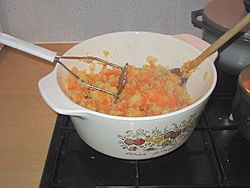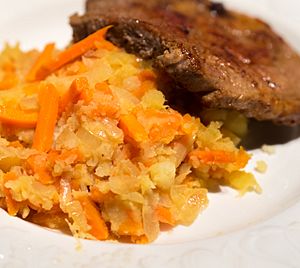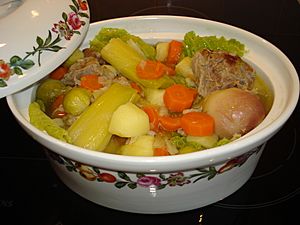Hutspot facts for kids
 |
|
| Place of origin | The Netherlands |
|---|---|
| Main ingredients | Potatoes, carrots, onions |
Hutspot is a classic and tasty dish from the Netherlands. It's made by boiling and mashing potatoes, carrots, and onions together. You might also hear it called hochepot in French or hotchpotch in English. This dish has a long history in traditional Dutch cuisine. Because of past connections, Hutspot is also found in Indonesian cuisine.
Contents
The Story of Hutspot
A Legend from Leiden
The story of Hutspot is quite famous in the Netherlands. It's linked to a big event called the Siege of Leiden in 1574. This happened during the Eighty Years' War, when the Dutch were fighting for their freedom from Spain.
Spanish soldiers had surrounded the city of Leiden. The people inside were running out of food. To save the city, the Dutch decided to break open the dikes. Dikes are walls that keep the sea or rivers from flooding the land.
When the dikes were opened, water rushed into the low-lying fields. This forced the Spanish soldiers to leave quickly. As they left, they supposedly left behind a pot of cooked vegetables. This pot contained what would become the first Hutspot.
Celebrating Freedom
The city of Leiden was saved on October 3, 1574. This day is still celebrated every year as Leidens Ontzet. People in Leiden and Dutch people all over the world celebrate this special day. A big part of the celebration is eating lots of hutspot. It reminds everyone of the city's freedom and the end of the siege.
Ingredients for a Classic Hutspot
Traditionally, hutspot is cooked with a type of beef called klapstuk. This is a cut of meat from the rib area of a cow. It has some fat, which makes it perfect for slow cooking in the same pot as the vegetables. If klapstuk isn't available, people often use smoked bacon instead.
The carrots used for hutspot are usually a special kind called winter carrots. These carrots give the dish its unique and delicious flavor. Regular carrots just don't taste quite the same in Hutspot.
The Potato's Journey
Potatoes are a main ingredient in Hutspot today. But they didn't arrive in Europe until the 1500s. The first European to write about the potato was Juan de Castellanos in 1537. Potatoes spread slowly across Europe after that.
So, the original legend about the Spanish soldiers might have actually referred to a different vegetable. Before potatoes were common, the Dutch used a vegetable called pastinaak. This is a parsnip, which looks a bit like a white carrot. Parsnips played a similar role in Dutch cooking before potatoes became a popular food.
What's in a Name?
The word hutspot roughly means "shaken pot" in Dutch. It's similar to the English word hotchpotch. Both words used to describe a mix of meat and barley stew. Over time, "hotchpotch" came to mean any confused mix of things.
The word hochepot was used for a food dish as early as 1440. This was more than a hundred years before the Siege of Leiden. So, the name itself has a very old history, even if the exact dish changed over time.
Other Mashed Dishes
Dutch Winter Warmers
Hutspot is more than just a side dish; it's a hearty meal. It's very popular during the cold Dutch winters. The Netherlands has many other mashed potato dishes, often called stamppot.
Some popular stamppot variations include:
- boerenkool (which means "farmers' cabbage" or kale)
- andijvie (endive)
- spruitjes (Brussels sprouts)
- zuurkool (sauerkraut)
These stamppot dishes are often served with rookworst (smoked sausage) or smoked bacon. What makes hutspot special is its chunky texture. It's not as smoothly mashed as some other potato dishes.
Similar Dishes Around the World
Other countries have similar mashed vegetable dishes too.
- In Sweden, there's a dish called rotmos, which means "root mash". It's similar to Hutspot but uses swede (a type of turnip) instead of onions.
- In Wales, there's a traditional dish called Potch. It's made with mashed potato, carrot, swede, parsnip, and sometimes other root vegetables.
- In the UK and other places, a dish of chopped potato, onions, and other ingredients is called a hash.
It's important to know that the Dutch hutspot is different from the Flemish hutsepot. The Flemish version is a meat stew with vegetables that are not mashed.
See also
 In Spanish: Hutspot para niños
In Spanish: Hutspot para niños



